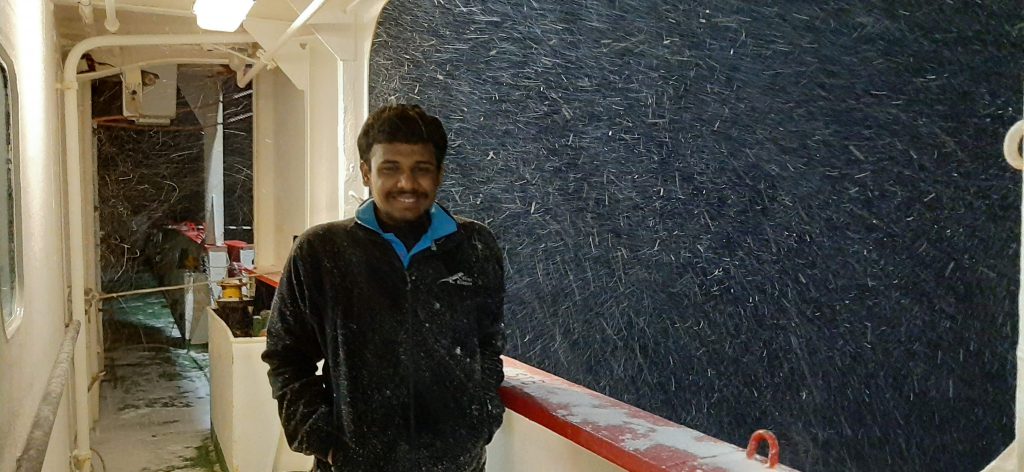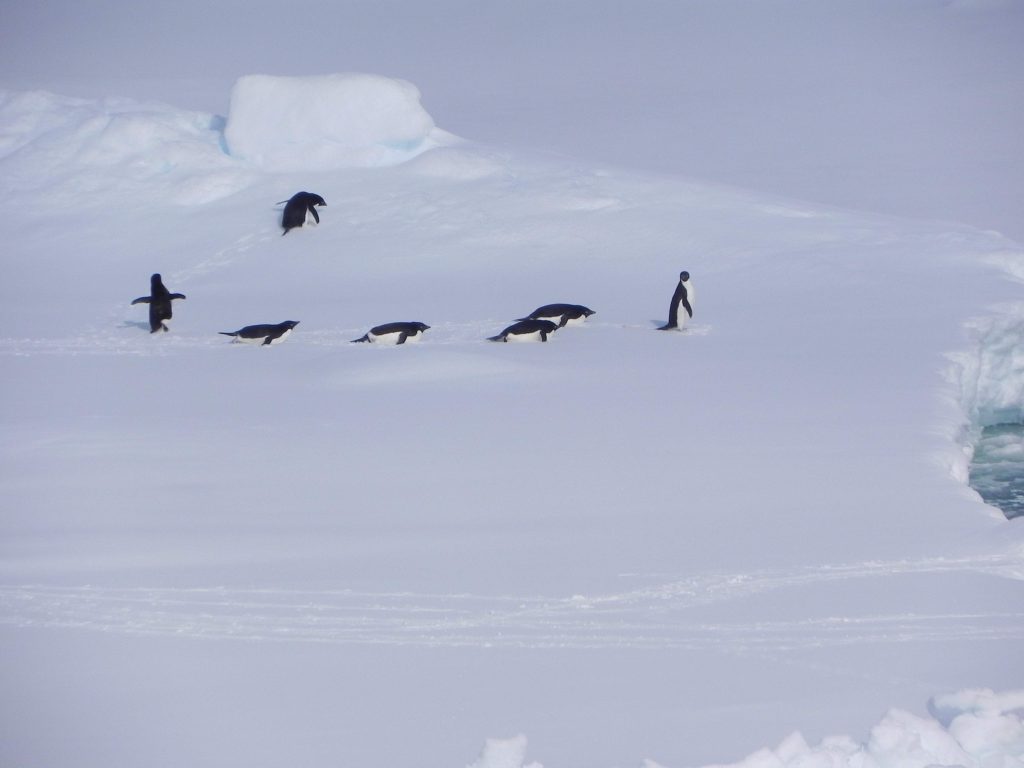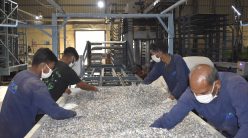Two IISc students recount their expeditions into the unknown

Satya Chanakya jolted awake when he fell off his bed in the middle of the night. He felt disoriented, wondering if he was dreaming. The room was swaying around him, and he heard a series of announcements through a speaker, asking everyone to remain in their rooms. As he lay on the floor trying to gather his thoughts, it struck him that he was on a ship thousands of kilometres from the nearest landmass, in the middle of the Southern Ocean. A far cry from a typical day as a doctoral researcher.
A PhD student at the Centre for Earth Sciences at IISc, Satya was travelling to the Southern Ocean to collect samples of the ocean bed for his research. Just six months before, in July 2019, Satya and his advisor, Sambuddha Misra, had submitted a research proposal under the Indian Southern Ocean Research Programme. He wanted to study how the Southern Ocean contributed to the end of the last ice age, about 18,000 years ago.
The Southern Ocean, also called the Antarctic Ocean, is one of five ocean basins on the planet, surrounding the continent of Antarctica. It plays an important role in regulating global climate by absorbing heat and CO2 from the atmosphere and driving global ocean circulation. The part of it that lies between India and Antarctica is considered to be the least explored. “Studying this part is vital because it contains the largest volume of oceanic water in the Southern Ocean without any nearby landmass,” says Satya.
The Earth cycles through glaciation and deglaciation, first freezing for tens of thousands of years, melting briefly, and then freezing again. The last deglaciation occurred about 18,000 years ago. This happens when CO2 levels in the atmosphere increase beyond a certain saturation level; during the last deglaciation, there was an increase of 100 ppm (parts per million) of CO2 in the atmosphere. Researchers hypothesised that the Southern Ocean was the main contributor to this CO2 rise, but they needed proof.
That is what Satya had set off on this journey for. But he had no idea that this would turn out to be an adventure of a lifetime.
To the end of the Earth
On a bright sunny morning in January 2020, Satya and a crew of scientists from different institutes in India boarded the research vessel Agulhas I in Mauritius. Named after an ocean current and plateau in the Indian Ocean, Agulhas I was an “icebreaker” – a ship designed to cut through 100 km-long ice sheets that are typically encountered enroute to Antarctica.
Along the way, the ship anchored at multiple locations mid-ocean, called stations, to collect ocean water and ocean bed sediment samples. The researchers on board were divided into teams, each assigned a station to take control of. As station managers, they worked with the captain and the drilling engineers to deploy the sample collectors and sensors. At each station, gravity and box core collectors would be sent down into the ocean bed, about three kilometres below sea level, to obtain ocean bed sediment, also called ‘core samples’.

Once the core samples were extracted, Satya’s team would swing into action. Using custom-made tools, they would cut the core into smaller sections and sort them with utmost care.
Satya’s goal was to identify trace elements in the core samples, particularly boron and its isotopes. Boron is an established proxy indicator for reconstructing past ocean pH levels, which in turn are influenced by atmospheric CO2 concentrations. Since these elements are present in minute quantities in the samples, they need to be dealt with extreme care to prevent contamination from external sources, such as cutting tools. It took about 10 hours to cut each core sample into one-centimetre-thick sections. The work was labour-intensive, and other teams would often pitch in.
It took about 10 hours to cut each ocean bed core sample into one-centimetre-thick sections
After 15 months of meticulous analysis of the samples, Satya found significant changes in the boron isotope concentrations around the time the last deglaciation occurred. They finally had the proof that the Southern Ocean did indeed largely contribute to the increase in CO2 levels during the last deglaciation cycle.
“Climate prediction models are trained on past climate data. The better the quantity and the quality of past data, the more reliable the predictions of the model would be. Understanding the effect of high CO2 levels on the past climate can help foresee their effect on future climate change. COP, IPCC and major climate summits use these model predictions to draft economic policies to tackle climate change,” says Satya.
Deep dive into the past
About two years after Satya’s successful expedition to the Southern Ocean, Pratyusha Chanda, another student from the Centre of Earth Sciences, set out on an ocean research expedition, this time to the Agulhas Plateau, an oceanic plateau in the south-western Indian Ocean, about 500 km below South Africa. She had applied for a research expedition through the International Ocean Discovery Program (IODP), an international marine research collaboration of about 21 nations, of which India’s Ministry of Earth Sciences is a key funding partner.
Through this expedition, Pratyusha was looking to resolve a geological conundrum much farther in the past – how much did the Chicxulub asteroid’s impact on Earth 66 million years ago contribute to the global mass extinction event that also killed the dinosaurs. This is known as the Cretaceous-Tertiary (K-T) boundary extinction in which 70-80% of all species on Earth at that time were eliminated.

A competing theory claims that an intense volcanic eruption that occurred 66 million years ago in the western Indian Ocean, which covered the atmosphere with toxic gases, was the main reason for the dinosaur extinction. “Scientists now theorise that both these events contributed to the extinction. Part of my work is to estimate the relative contribution of these events,” explains Pratyusha.
To understand how much the asteroid impact contributed to the mass extinction, Pratyusha and her team were looking to analyse levels of an element called osmium, which is found in higher amounts in asteroids than on Earth. They wanted to obtain high quality K-T boundary sediments from the Indian Ocean bed and study their osmium isotope signatures. If high amounts of osmium are detected at the K-T boundary, then it would prove that this is due to additional osmium from the asteroid impact.
Pratyusha’s expedition set off from Cape Town, South Africa in February 2022, with a crew of researchers from Germany, UK, China, and USA, amongst other nations. After they had settled aboard the JOIDES Resolution research vessel, the scientific crew was split into day and night shifts. In this expedition, the ocean bed cores retrieved were deeper than Satya’s, about five kilometres below sea level. Once the drilling engineers on deck retrieved the cores, Pratyusha would get to work in the core lab. As a sedimentologist, she would analyse the core in detail – examining its physical features such as colour, grain size, texture; categorising different climatic events of the past through radiocarbon dating, and documenting everything along with photos to build a repository for future explorers.
Pratyusha was looking to resolve a geological conundrum from 66 million years ago
Multiple expeditions to various oceans had previously failed to obtain the K-T boundary sediment because very few ocean beds worldwide have this sediment well-preserved. The Agulhas Plateau was considered one such exception. Pratyusha and her team successfully retrieved the sediment intact through seismological analysis and careful drilling of the ocean bed.
“Everyone cheered when we got the K-T boundary sediment for the first time,” recalls Pratyusha.
Experience of a lifetime
Life on board a ship was drastically different from that on land for both researchers. As they sailed across latitudes and longitudes, days and nights blurred into one another, and they lost sense of time passing. Satya’s ship followed the GMT regardless of the conditions outside, to stick to a daily routine. On their 70-day voyage, Satya and the crew also experienced frequent and intense storms. “I did not know swimming, but it would not have helped anyway,” comments Satya.

The researchers were advised to always take a companion on deck while sailing. The ship was enormous, and if someone were to go missing, people would not even realise it for a few days. They would assume you are elsewhere on the ship. Satya recalls a rather ominous briefing when they boarded the ship: “We will know not to search for you if you accidentally fall off the ship. We will mourn you. If you fall off the ship, it’ll be half an hour by the time we can stop the ship. But by then, you’d have been carried far away by the strong currents of the Southern Ocean. We might try, but we will surely not retrieve you alive. You’d be frozen before we even halt the ship to mount a rescue.”
The Indian part of the Southern Ocean is tumultuous. Since there is no land mass around it, winds are heavy, and the currents are strong. Although the ocean temperature is -3°C, the strong winds make it feel like -30°C. “One day, during my duty on the deck, the ship tilted, and I got dragged about five metres on the ship floor before I found a hook to hold on to, or else I could have slipped and fallen into the ocean. Another time, the winds were so intense, I could not stand. I had to crawl back under cover,” says Satya.
“We will know not to search for you if you accidentally fall off the ship. We will mourn you”
The scientific instruments and equipment on board were locked to tables with nuts and bolts to prevent them from sliding off. The lunch plates would stick to the adhesive mats on the dining room tables. Despite the shaky dining experiences, the cooks managed to make scrumptious cakes, cookies and ice creams on birthdays and special occasions such as Republic Day to feed the ravenous researchers. “The Madras mutton curry was my favourite,” says Pratyusha.
But amidst the challenges, there were also moments of wonder that allowed the researchers to experience natural beauty. Satya remembers seeing whales, seals, penguins, and even bioluminescent algae during the expedition, which lit up as the waves hit the ship. Pratyusha also loved the moments of peace on deck to witness the sunset every day. “It became a ritual for us to gather around and see the sunset. The ship would turn off the lights in transit, and we would go to the upper decks at night to soak in the clear skies full of stars.”
It is important for researchers to participate in such ocean expeditions themselves, they both emphasise, as it helps them gain experience in handling core samples and know what mistakes to avoid. “As a beginner, we might know what to do with the core samples, but we don’t know what not to do,” says Satya. Mishandling the samples can give spurious results, and these can be avoided if the researcher is involved in the sample collection stage itself. “Your specialisation and presence are necessary as you direct the sample collection and handling in real-time according to the sample requirements for your research,” says Pratyusha.

Beyond technical skills, the experience offered other skill development too. For Pratyusha, it was her writing and presentation skills. “Every week, we had to note our observations of the core samples with detailed descriptions and present a progress report,” she says. Satya says that his social skills too vastly improved due to sharing space with all kinds of people. “I learnt to adjust because nothing was under my control – not the food, climate, friends, or even time zones. We lose connection with the outside world; it is like a Bigg Boss house. You get to know people well in a short time because you see them at their worst – exhausted, hungry, irritated, scared, sleep-deprived, sad, and homesick – and how they react to these situations.”
When their expeditions ended, Satya and Pratyusha were relieved to set their feet back on stable land safely. But they continue to remember their time at sea with great fondness. Satya says: “There was always something to do on the ship. There was always someone who needed your help. So, if you are willing to help and learn, you never get bored.”
Sankeerthana Avasarala is a PhD student at the Department of Materials Engineering, IISc and a science writing intern at the Office of Communications




